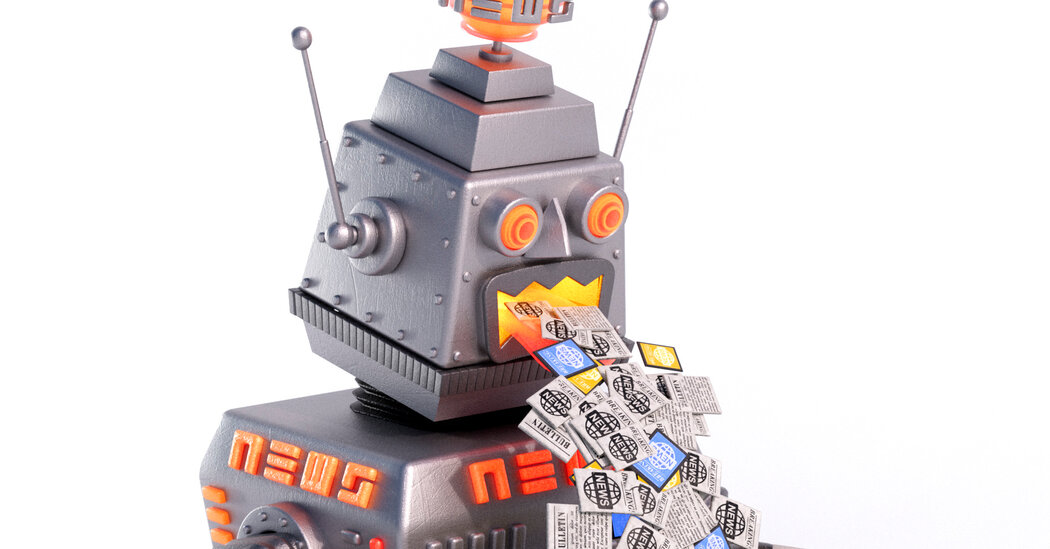Copyright The New York Times

Ryan Sabalow, a reporter for the newsroom CalMatters, noticed something peculiar when he began covering California lawmakers in 2023. Politicians would often give impassioned speeches against a bill, then refrain from voting entirely. He began to wonder how often legislators were ducking tough votes — and how that influenced California’s laws. Not long ago, those questions would send Mr. Sabalow scurrying to some dreary records room or scrolling through a spreadsheet. In the dawning age of generative artificial intelligence, all he had to do was ask a machine. He and his team turned to an A.I. tool, Digital Democracy, which tracks every word uttered in California legislative sessions, every donation and every vote taken. It led to an article, and an Emmy-winning segment on CBS, that revealed that Democratic lawmakers had killed a popular fentanyl bill by not voting at all. “I don’t think I could have done that without this database,” Mr. Sabalow said. Artificial intelligence is sweeping through newsrooms, transforming the way journalists around the world gather and disseminate information. Traditional news organizations increasingly use tools from companies like OpenAI and Google to streamline work that used to take hours: sifting through reams of information, tracking down sources and suggesting headlines. In some cases, including at Fortune and Business Insider, publications have explored using A.I. to write full articles, notifying readers they intend to use it for drafts. Almost all of the news organizations have some guardrails in place to prevent errors, such as requiring a human to review anything that A.I. writes before it is published. But some embarrassing errors have appeared nonetheless, including from top publications such as Bloomberg, Business Insider and Wired. And many journalists have also been left to wonder: Will A.I. replace journalism jobs in an already fast-shrinking market — or, rather, which jobs? “A.I. is an extraordinary tool for journalists,” said Stephen Adler, a former editor in chief of Reuters who now runs the Ethics and Journalism Initiative at New York University. “It excels at analyzing large data sets, organizing notes, checking spelling and grammar, even pointing out possible flaws in a story. But, as with much of technology, it comes with significant risks.” The stakes are incredibly high for the news industry. Over the past several decades, media executives watched as the internet upended their business, laying waste to classified advertising and siphoning away readers to social media. And many have come to realize they were flat-footed in the face of the technology transformation, giving away news content in the hopes of clawing back some digital advertising revenue. The executives are eager to not make the same mistake with A.I. They are trying to force tech giants to pay for the original content used to train and service the large language models, either through commercial agreements or lawsuits — or both. (The New York Times, which has an A.I. licensing deal with Amazon, has sued OpenAI and its partner, Microsoft, claiming copyright infringement of news content related to A.I. systems. OpenAI and Microsoft have denied those claims.) Proponents of A.I. in newsrooms say that regardless of the business implications, the technology is a powerful new tool to aid with reporting and editing and engage readers. And they are racing to figure out how to take advantage of that. Newsquest, a British newspaper chain owned by USA Today Company, employs more than 30 journalists who use A.I. to delve deeper into stories. Axel Springer, the Berlin-based owner of Politico and Business Insider, recently used A.I. to create an interactive travel planner. Time magazine used an A.I.-powered chatbot for its 2024 Person of the Year featuring President Trump. The New York Times has a team that experiments with A.I. and builds reporting tools. Axios, the Beltway publication that has been outspokenly pro-A.I., is experimenting with the technology for its Axios Local newsletters and automating news roundups by using OpenAI’s ChatGPT to find the most relevant news stories of the day, with oversight by a reporter, said Allison Murphy, the chief operating officer of Axios. “The efforts to automate are not about cutting quality corners. It’s not about dropping reporter jobs,” Ms. Murphy explained. “It’s about anything that isn’t human expertise: Let’s find the best, fastest way to do it.” Axios has also developed the Axiomizer, an A.I. tool to help generate the outlet’s trademark axioms such as “why it matters” and “one big thing.” Ms. Murphy said reporters were able to chat with the tool to get recommendations and edits. The Associated Press used A.I. tools this year to quickly sort through tens of thousands of pages of documents relating to the assassinations of President John F. Kennedy, the Rev. Dr. Martin Luther King Jr. and Robert F. Kennedy. The tools made the documents searchable and summarized them, while also allowing journalists to see which parts of the files had been unredacted for the first time. “That would have taken a lot of time, just to go page by page to find the places that are unredacted,” said Troy Thibodeaux, the director of A.I. products and services at The A.P., adding that the tools very likely saved reporters “days’ worth of work.” But there has also been some pushback within news organizations. This year, a staff engineer for The Washington Post raised concerns about a new tool under development that would summarize and aggregate news articles from publications across the internet, according to two people familiar with the matter. A lawyer for The Post also weighed in, saying it could be a violation of intellectual property rights, the people said. Vineet Khosla, The Post’s chief technology officer, pushed back against the engineer, who later quit and cited the potential unethical use of A.I. The Post eventually released a different A.I. aggregator that helps run a scrolling marquee of headlines. A spokeswoman for The Post said in a statement that the discussion had taken place in a “proof-of-concept” meeting, noting that those conversations “continuously evolve." At Bloomberg, an experiment with A.I. to generate news article summaries has resulted in dozens of corrections. A note appended to one, an Aug. 1 article about Switzerland’s reaction to President Trump’s tariffs, said: “A faulty A.I. summary was removed for misrepresenting surplus as a deficit.” And the publication removed a summary on a Sept. 22 feature about private equity because it had misattributed a quote. Bloomberg has said that 99 percent of A.I. summaries met the outlet’s editorial standards and that journalists had full control over whether a summary appeared. “We’re transparent when stories are updated or corrected, and when A.I. has been used,” the company said in a statement. Newsroom unions have channeled many journalists’ concerns about A.I.’s replacing them. The NewsGuild, a labor union for journalists, has worked on 48 collective bargaining agreements since late 2023 involving A.I. in some way, whether around job security or guardrails for its use, said Jon Schleuss, the organization’s president. (The NewsGuild represents some workers at The Times and at Wirecutter, a product recommendation website owned by The Times.)



